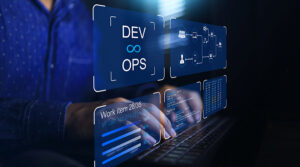The rise of DevOps has opened many opportunities for candidates to find a great position and kickstart a secure and satisfying career. But before candidates can celebrate their new job, they must first ace the interview; for that to happen, they must be prepared.
This article helps you prepare by offering a sample of some of the most popular DevOps interview questions and answers, especially on DevOps engineer questions. We break down the questions into a general category and then dedicate space to a few specific DevOps topics, such as Azure and AWS. We’ll also share a DevOps bootcamp you can take to upskill.
But before we launch into the questions, let’s establish some definitions.
What is DevOps?
The term “DevOps” is a portmanteau of the terms “development” and “operations.” The term is a combination of software development (the “Dev” part) and Information Technology operations (the “Ops”). DevOps was designed to improve software development, delivery, and deployment quality and efficiency.
DevOps’ primary purpose is to encourage teamwork between the development and operations teams, allowing them to collaborate across the entire software development life cycle easily. Additionally, DevOps uses automation, continuous integration, delivery, and deployment to speed up and reduce errors in the software development process.
Also Read: DevOps Tutorial: How to Install Docker on Ubuntu?
What is a DevOps Engineer?
DevOps engineers are experts in developing, deploying, and maintaining software systems using DevOps practices and methodologies. DevOps engineers work closely with software developers, IT operations teams, and other stakeholders to guarantee effective software product delivery. They are responsible for implementing automation, continuous integration, and continuous delivery/deployment (CI/CD) practices, thereby increasing software development efficiency and quality. Additionally, DevOps engineers find and resolve issues that arise during all stages of the development process.
Now, let’s dig into some DevOps interview questions and answers.
General DevOps Interview Questions
Here’s a sample of the more popular DevOps engineer interview questions.
Q: Why is DevOps even necessary in the first place?
- A: There has been a general trend among software developers to experiment with delivering smaller groups of features to their customers via a series of release trains instead of releasing large feature sets. This approach results in better software quality, rapid customer feedback, and high customer satisfaction and retention. To make this approach work, organizations must:
- Increase deployment frequency
- Lower new release failure rate
- Shorten the lead time between fixes
- Reduce recovery meantime if the new release crashes
DevOps meets these requirements and, as a result, has gained increased acceptance in the IT world.
Q: What is expected of a DevOps engineer?
- A: Here are the primary functions of a DevOps engineer:
- Facilitating collaboration and communication between development, operations, and other cross-functional teams, ensuring smooth workflows and aligned goals.
- Developing and implementing automated processes for creating, testing, and deploying software, plus managing infrastructure and configuration.
- Using Continuous Integration/Continuous Delivery (CI/CD) pipelines to facilitate frequent, reliable software releases.
- Implementing Infrastructure as Code (IaC) principles to manage infrastructure and configuration via code, allowing easy scaling and replication.
- Setting up monitoring tools and performance metrics to encourage system stability, identify faults and issues, and enable rapid and proactive problem-solving.
- Integrating security measures into the development and deployment processes while ensuring compliance with accepted industry standards and regulations.
- Utilizing cloud platforms and services like AWS to construct scalable and resilient applications and infrastructures.
- Resolving software deployments, performance, and infrastructure issues and providing technical support to development and operations teams.
- Continuously learning and remaining up-to-date with the latest DevOps technologies, tools, and best practices needed to improve the company’s software delivery processes continuously.
Q: List some popular DevOps tools.
- A: Popular tools include:
- Ansible
- Chef
- Docker
- Git
- Jenkins
- Puppet
- Selenium
Q: Talk about the various phases of DevOps.
- A: The phases of the DevOps lifecycle are:
- Plan: Plan the type of application that must be developed.
- Code: Code the application as outlined in the end-user requirements.
- Build: Build the application by integrating the series of codes created in the previous steps.
- Test: Test the application and rebuild it if necessary. This is the most vital step of the application’s development.
- Integrate: Integrate the multiple codes from different programmers into one.
- Deploy: Deploy the code into a cloud environment for further usage while ensuring that any new changes don’t affect the functions of a typical high-traffic website.
- Operate: Operations are conducted on the code if needed.
- Monitor: Monitor the application performance, making any changes to meet the end-user requirements.
Q: List some of the primary benefits of DevOps.
- A:
- Continuous software delivery
- Less complex problems to deal with
- Early detection and faster correction of faults and defects
- Faster feature delivery
- Stable operating environments
- Improved collaboration and communication between the project’s teams
Q: List DevOps’ key components.
- A:
- Continuous Integration
- Continuous Delivery
- Microservices
- Infrastructure as Code
- Monitoring and Logging
- Communication and Collaboration
Q: How do you approach a project that requires DevOps?
- A: It’s a three-stage process:
- Stage one: Dedicate several weeks to assessing the existing process and implementation, identifying areas of improvement so the team can create an implementation road map.
- Stage two: Create a proof of concept (PoC). Once the PoC is accepted and approved, the team can start implementing and rolling out the project plan.
- Stage three: The team can now implement DevOps to the project using the steps of version control, integration, testing, deployment, delivery, and monitoring.
Q: List DevOps’ key performance indicators (KPI).
- A:
- Change Failure Rate
- Change Lead Time
- Change Volume
- Deployment Frequency
- Deployment Failure
- Efficiency
- Mean Time to Detection
- Mean Time Between Failures
- Mean Time to Recovery
- Performance
- Pipeline Adoption
Q: Now, which of those KPIs are the most important?
- A:
- Meantime to failure recovery: This measures the average time spent to recover from a failure.
- Deployment frequency: This indicates the frequency in which the deployment occurs.
- Percentage of failed deployments: This indicator is the number of times the deployment fails.
Q: What’s continuous testing?
- A: Continuous Testing describes running automated tests as part of the software delivery pipeline, providing instant feedback on present business risks present in the latest release. Each build is continually tested to prevent problems in side-switching during the delivery’s lifecycle and allows the Dev team to get immediate feedback.
Q: And what’s automated testing?
- A: Automation testing uses independent testing tools to let you develop test scripts that can be run repeatedly without human interaction.
Q: Why is AWS a good platform for DevOps?
- A: AWS offers the following benefits for DevOps:
- It provides ready-to-use, flexible services that don’t require software installation or setup.
- Developers can manage a single instance or scale to thousands of instances.
- It lets you automate tasks and processes, freeing up your time, which can be better spent doing more exciting and challenging tasks.
- It provides good security by letting you set user permissions and policies.
- It supports an extensive partner ecosystem that can integrate with and extend AWS services.
Q: Discuss the differences between Agile and DevOps.
- A: The differences can be broken down like this:
- Agile is an iterative approach focusing on development, while DevOps merges development and operations.
- Agile manages complex projects, while DevOps manages end-to-end engineering processes.
- Agile uses tools like Kanboard, JIRA, and Bugzilla, and DevOps uses tools like AWS, Puppet, and Chef.
- Agile supports Agile release cycles, while DevOps uses shorter release cycles and supports defect detection.
- Agile enjoys self-feedback, while DevOps gets its feedback from its clients.
Q: What’s the point of continuous integration (CI)?
- A: Continuous integration automates code change integration from different contributors to a single software project. By regularly integrating, developers can quickly detect errors and easily locate them. Source code version control is the main point of the CI process.
Q: List the benefits of continuous integration.
- A:
- Faster development cycles
- Smarter risk mitigation
- Stable codes
- Team communication
- Reduced overhead
- Flexibility
- Consistency of the build process
Also Read: A DevOps Engineer Job Description for Aspiring Professionals
DevOps Interview Questions for Source Code Management: Git
Q: What is Git?
- A: Git is a Distributed Version Control system (DVCS) that tracks file changes and lets users revert to any change.
Q: What’s the Git command to download a repository from GitHub to a computer?
- A: Git clone
Q: What is Git Bisect?
- A: Git bisect uses a binary search to find the commit that introduced a bug.
Q: What is branching?
- A: You use branching when you want to add a new feature to your app. Create a new branch split off from the master branch, then build the feature on that new branch.
Q: How do you revert a commit that’s already been pushed and made public?
- A: Either fix or remove the bad file in a new commit, then push it to the remote repository, using the git commit -m “commit message” command to commit it to the remote repository once the changes are made, or use git revert <name of bad commit> to create a new commit to undo all the changes made in the bad commit.
DevOps Interview Questions for Continuous Integration: Jenkins
Q: What is Jenkins?
- A: Jenkins is an open-source continuous integration server that lets developers achieve a Continuous Integration process in an automated manner. Jenkins can also highlight any errors in the early stages of a project.
Q: What kinds of plugins does Jenkins use?
- A: Plugins include Dashboard View Plugin, View Job Filters Plugin, Exclusion, GitHub/GitLab Pull Request Builder, Hudson Extended Read Permission Plugin, Post+build+task, Amazon EC2, and HTML publisher.
Q: Can you build multiple jobs simultaneously in Jenkins?
- A: Yes. After the parent job is implemented, other projects or jobs can be implemented automatically. We use a pipeline multibranch plugin to create jobs automatically.
Q: Explain Jenkinsfile.
- A: Jenkinsfile is a text file with the Jenkins pipeline definition and checked into the source control repository. Jenkinsfile allows pipeline code review and iteration and permits an audit trail for the pipeline.
Q: How do you make a new build job in Jenkins?
- A:
- Log on to the Jenkins dashboard, and click on the new item at the dashboard’s top left side.
- Enter the item name, then click on the freestyle project.
- Enter the details of the project you’re testing.
- Enter your repository URL under the source code management.
- Under the build, click on “add build step,” and click the execute Windows batch command.
- After you enter the data, click on Apply and save your project.
- Click on the “Build Now” button to build your source code.
- Click on the build number and the console output when you want to check the status of the build you’re running.
DevOps Interview Questions for Continuous Testing: Selenium
Q: What testing types does Selenium support?
- A: Selenium supports functional, regression, and load testing.
Q: Break down Selenium’s components.
- A: Selenium consists of:
- Selenium Integrated Development Environment (IDE)
- Selenium Remote Control (RC)
- Selenium WebDriver
- Selenium Grid
Q: What’s the difference between the Assert and Verify commands?
- A: Verify determines if a provided condition is true, while Assert determines if a condition is either true or false.
Q: When do you use Selenium Grid, and how does it work?
- A: Use Selenium Grid while executing the same or different test scripts on multiple browsers and platforms. The Grid sends tests to the hub, which are subsequently rerouted to Selenium Webdriver. Selenium Grid then launches the browser and runs the tests parallel to the whole test suite.
Q: Can you use Selenium Grid for performance testing?
- A: Yes, but you’re better off using a dedicated Performance Testing tool like Loadrunner.
DevOps Interview Questions and Answers on Containerization
Q: Why is it better to use Containerization instead of Virtualization?
- A: Because of these four reasons:
- Containers allow real-time scalability and provisioning, while Virtual Machines (VMs) provide slow provisioning
- Containers display superior performance over VMs, such as more memory space
- Containers are more lightweight than VMs
- Containers provide better resource utilization than VMs
Q: How can you run multiple containers on a single service?
- A: Use Docker Compose to run multiple containers. Each container runs in isolation but can still interact with the others. Docker Compose files are YAML (yet another markup language) files.
Q: Speaking of Docker, explain its architecture.
- A: Docker employs a client-server architecture. Docker Client is a service that runs commands that are translated by REST API and sent to the server, Docker Daemon. The server accepts the request and interacts with the OS to run Docker containers and build Docker images. Docker images are instruction templates used to build containers. Containers are executable packages of applications and their dependencies. And finally, the Docker Registry is a service that hosts and distributes images among the users.
Q: Which cloud platforms support Docker?
- A: The cloud platforms that support Docker include:
- Amazon Web Services
- Microsoft Azure
- Google Cloud Platform
- Rackspace
Q: Explain Docker Swarm.
- A: Docker Swarm is a tool designed for Docker containers and handles clustering and scheduling. Swarm helps users establish and manage Docker node clusters as a single virtual system.
Also Read: How to Become a DevOps Engineer: A Complete Guide
DevOps Interview Questions for Continuous Monitoring
Q: Explain why you should use continuous monitoring.
- A: Users can employ continuous monitoring to quickly detect and measure the security implications of any unscheduled changes and determine the vulnerabilities present in any information fault or threat.
Q: How do you perform continuous monitoring?
- A: Use an Application Performance Management (APM). An APM can monitor, analyze, and manage various applications and IT infrastructures.
Q: Explain Nagios in the context of continuous monitoring.
- A: Nagios is a continuous monitoring tool for applications, services, systems, business processes, etc. Nagios alerts tech staff about problems before they become major issues that threaten outages.
Q: Explain the concept of a Nagios Remote Plugin Executor.
- A: A Nagios Remote Plugin Executor (NRPE) lets you execute a Nagios plugin on a Linux or Unix machine. You can use an NRPE to monitor remote machine metrics such as disk usage, CPU load, etc.
Q: What are some other continuous monitoring tools besides Nagios?
- A: Tools include:
- Lansweeper
- SolarWinds
- Spiceworks
- Snort
- Tenable
DevOps Interview Questions for Version Control Systems
Q: What’s a version control system?
- A: A version control system, or VCS, is a software tool that lets developers manage changes to a software project’s source code. Developers can collaborate with others, track and manage different versions of code files, and revert to earlier versions if needed.
Q: Explain the benefits of a version control system.
- A:
- You can track changes to code over time
- You can collaborate with fellow developers and share code
- You can change back to earlier versions of the code if needed
- You branch code and simultaneously work on different features or fixes
- It grants the ability to merge changes from other contributors and branches
- You gain increased confidence and control over code deployments and changes
Q: Explain the two types of VCSs.
- A:
- Centralized. The centralized VCS has one central repository that stores every version of the code files. Developers can then check out files from this central repository, make needed changes, and commit them back to the warehouse.
- Distributed. The distributed VCS lets developers create their own local repositories of code changes. So, developers can work on their code changes locally, commit any changes to this local storage, and then push them to their central repository or pull desired changes from other contributors.
Q: Explain the difference between SVN and Git.
- A: SVN and Git are VCS tools, but SVN is a centralized VCS, and Git is a distributed VCS. Git offers greater flexibility and speed, while SVN has better binary file support.
Q: Discuss the three VCS branching strategies.
- A:
- Feature Branching. Feature branching ensures that a project’s particular feature is maintained in a branch. When the feature is fully validated, the branch is merged into the main branch.
- Task Branching. In task branching, each task is maintained in its own branch, and the task key becomes the branch name. This naming convention makes it simpler to identify which task is being covered in which branch.
- Release Branching. Release branching is used after a set of features designated for release is completed. They can then be cloned into a branch named the release branch. No additional features can be added to this branch, and it’s typically reserved for documentation, bug fixes, and release-related activities. Once everything has been completed, the releases are tagged with the version number and merged into the main branch.
How to Take Your DevOps Skills to a Higher Level
The more you know, the easier the job interview goes. Therefore, if you want to hedge your bets and ace that crucial DevOps engineer interview, consider taking this informative online DevOps course. This 36-week DevOps bootcamp bridges the gap between software development and operations and teaches hands-on skills via industry projects in continuous deployment and DevOps tools such as Ansible, Terraform, Docker, and Kubernetes.
According to the Glassdoor.com job site, DevOps engineers working in the United States earn an annual average salary of $123,581. So, why wait? Sign up for this informative bootcamp and increase your chances of landing that sweet DevOps position!
You might also like to read:
What is Azure DevOps? A Complete Guide
The Top Data Science Interview Questions for 2023






